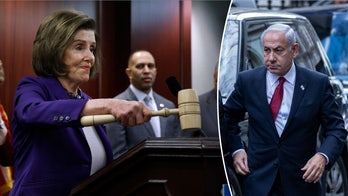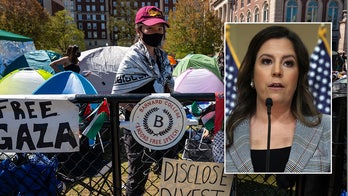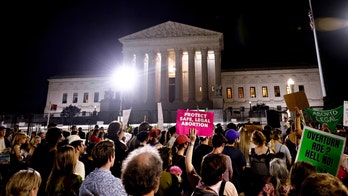Leading federal health officials warn Congress about reopening America too soon
Senate holds historic hearing as witnesses testify via video conference; chief congressional correspondent Mike Emanuel reports.
Get all the latest news on coronavirus and more delivered daily to your inbox. Sign up here.
I heard the dog before I saw it.
As I cut across the East Front of the U.S. Capitol Plaza, traversing from the Senate side to the House side, I carried a few bottles of water and a turkey wrap sandwich in a paper bag as I headed to my office inside the Capitol.
I inhaled deeply, suctioning my black nylon mask against my nostrils and mouth for a moment. The mask constricted against my face, inflating in the other direction when I exhaled.
And then, I heard the dog, its paw steps pattering behind me. Out of the corner of my eye, I could see it slobbering.
Where was this dog from? Was it rabid? Was it trying to attack me? What about all of this business with animals maybe getting coronavirus -- and you’re not supposed to hang around unfamiliar dogs because you don’t know who has petted them and if they have it ...
To avoid the dog, I scampered a few feet to my right like a nimble third base coach hopscotching a sharp foul ball.
Then, I saw the leash – and then, the U.S. Capitol Police officer. The officer was coming right for me.
No one has walked directly at me since at least mid-March.
Instinctively, I trotted a few more steps away to maintain “six feet,” not sure what was going on.
“Oh, he’s just checking you,” said the assuring K-9 officer.
Whatever the dog did, it was satisfied with me and went galumphing off to assess a jogger. The police dog practically dragged its handler with him in the other direction.
I was startled. The Capitol Police often have dogs out checking people around the grounds. But, I don’t recall a canine coming up and sniffing like that. And, after weeks and weeks of deliberately staying away from people, crossing the street during early morning runs to avoid others and talking only from the porch or over the fence to neighbors, the dog and officer approaching me at close proximity shocked my system.
It was also a stark reminder that police still have their jobs to do. Sniffer dogs are still inspecting people carrying packages across the Capitol plaza. National Park Service Police are running radar on the George Washington Parkway. All, even amid a pandemic.
Of course we know why the dog is there at all.
A bomb tore through the Senate wing of the U.S. Capitol near the floor late at night on November 7, 1983. The “Armed Resistance Unit” positioned the bomb near the Senate chamber to protest U.S. military action in Lebanon and Grenada. U.S. Capitol Police stepped up security after that, adding metal detectors at entrances. Congressional security forces fortified Capitol Hill following 9/11, screening for aerosolized chemicals, biological agents. Security teams enhanced video surveillance as more officers roamed the grounds. And, of course, more dogs.
Seconds later, I walked around to the House Carriage Entrance, showed my plastic congressional pass to several officers wearing masks, opened two doors with my elbow, placed my phones and keys in a see-through plastic bag for the metal detector and scaled three flights of steps to the House Radio/TV Gallery to avoid using the elevator.
As I entered the U.S. Capitol, no one knew if I had coronavirus. No one knew if the jogger out on the plaza had coronavirus. There’s no way to tell if any of the officers working the door had coronavirus. No clue if an army of Capitol workers, hammering away at repairs on the House steps, had coronavirus. No idea if the skeleton staff of maintenance workers and custodians inside the Capitol that day had coronavirus.
But, I was permitted to enter the U.S. Capitol – the same as anyone else with the proper credentials – coronavirus or no coronavirus. I felt great. I presume everyone around me felt great. Otherwise, they would stay home, right? Who knows if any of us were asymptomatic? Any one of us could have been transporting the greatest pandemic of our time into the seat of American government and spreading it all over.
But, one thing’s for sure: The police dog out on the Capitol plaza could tell I wasn’t carrying a bomb.
This is all understandable. It is said in the military that generals always fight the last war.
Well, 9/11 was the “last” war. The police dog is a relic of that: still important, still crucial, but incongruent with the contemporary danger.
CORONAVIRUS: WHAT YOU NEED TO KNOW
The “war on terrorism” ushered in enhanced protocols to screen airline passengers. Air marshals are boarding flights. Jet fighters are kept “hot” 24/7 at nearby Joint Base Andrews, ready to scramble into action in case of an air incursion. If you run a food truck in D.C., don’t park too close to the Capitol around the time of the Memorial Day concert. Otherwise, the U.S. Capitol Police may have questions about your pressure cookers. Congress appropriated trillions of dollars to beef up the military and go to war in Afghanistan to eradicate terrorism. Lawmakers approved legislation such as the Patriot Act to boost surveillance and improve intelligence services. They cut out mail delivery to the Capitol after the anthrax attack in late 2001.
So far, pretty good, nothing close to 9/11. We’re still fighting in Afghanistan – nearly two decades on. The shoe bomber. There was the Times Square bomber in 2010. The 2011 arrest of a man who wanted to wear a suicide vest to the Capitol. Disaster averted. If you see something, say something.
But, we don’t have anything yet to combat coronavirus. No vaccine. No therapeutics. There aren’t enough tests.
There’s tension between lawmakers about providing testing to those who work on Capitol Hill – ranging from top congressional leaders themselves, all the way down through aides, USCP officers, custodians, food service workers and, yes, even heathen journalists. Those are the various cohorts of people who work inside the Capitol complex. If they’re going to be there – and you want to have some degree of a healthy work environment – then testing is essential. Otherwise, it’s a roll of the dice, like many other places in America.
If the Capitol got rapid testing, crews likely would assemble some sort of tent on the Capitol plaza, right around where I encountered the sniffer dog. You would do the test, then pass through security. It’s another layer, to be sure, but this is the world in which we live.
And, it’s not just Capitol Hill. We have very little information about the health of the general population who may have contracted coronavirus – whether they’re delivering the mail, shopping at the grocery, hitting the liquor store or dropping off pizza. The testing capacity doesn’t exist. There’s always risk.
They pretty much hardened every federal facility anywhere after 9/11. The U.S. Capitol is one of the most secure places in the world – and simultaneously, an appetizing target for terrorists.
“I guarantee you, this building is secure,” a former senior congressional security official told me years ago.
Secure from terrorists and bombings? It’s likely, because of everything put in place after 1983 and 9/11. That includes the police dog patrolling the plaza.
CLICK HERE TO GET THE FOX NEWS APP
Secure from coronavirus? The striking white dome doesn’t mean much to a virus. It’s just another place in which to potentially incubate.
In the early stages of this war, the U.S. Capitol is just as vulnerable as any place else.








